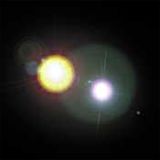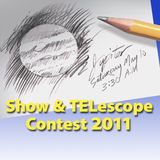
When it comes to astronomy, you will find the term "arc second" used in three ways: (1) to express a given distance in declination on a star chart, (2) as a given unit of an astronomical object's size, and (3) as an expression of telescope's resolving power. Let's take a look at each use of the term in more detail.
First, we'll examine how an arc second is expressed when applied to a star chart and to the visible night sky. Picture the entire dome of the night sky as the face of a clock. The clock is divided into hours, minutes, and tiny seconds. Much like this imaginary clock, the celestial dome is divided into degrees and each degree is comprised of arc minutes and arc seconds. There are 60 arc minutes in each degree, and each arc minute is made up of 60 arc seconds. But, just how big would that be? Let's use the full Moon as an example. It covers approximately 1/2 a degree of night sky - which equals 30 arc minutes or 1800 arc seconds. These measurements are abbreviated into a type of astronomical shorthand. Terms for the Moon's apparent size would read 30' for arc minutes or 1800" for arc seconds.
When you look at a star chart (How Do I Read a Star Chart?), you'll see degrees of declination - measurements from north to south — marked along the edge. Each degree of sky contains 60 arc minutes, or 3600 arc seconds. When using an astronomical catalog or observing instructions, you'll be provided with an "address" of coordinates to celestial objects which utilizes arc seconds. This address may read something like RA 12h 22m 13s — Dec +22° 44' 11". Look at the second set of numbers. This means your object is located twenty-two degrees, forty-four arc minutes, eleven arc seconds north of the celestial equator. Although a single arc second would be too small to visually determine when looking at the sky, it is very important to celestial surveys and catalogs. It is like assigning a celestial "house number" to a specific target and allows astronomers to locate targets with precision.
When expressing the size of an astronomical object, it is often given in terms of angular diameter as seen from Earth — not its true size. Most of the time, these angular diameters are very small since most objects are very far away from Earth, so they are expressed as arc minutes, or more frequently as arc seconds. An astronomical catalog or observing guide will provide an object's size to help observers better understand what to expect from a target before they try to locate it with a telescope. This is helpful if you have never seen a particular object. Let's use two samples to illustrate this concept - a globular cluster and a double star. For example, globular cluster M80 is listed as 10' (ten arc minutes) in size. A good star chart will show this object printed to scale in relationship to the stars around it. This makes identifying it from the surrounding stellar patterns seen in the eyepiece much easier. You knew in advance the cluster would cover a certain amount of distance between identifiable stars. However, the angular distance measurement between double stars is much smaller and is always expressed as arc seconds. A good example is Polaris. The main bright star, Polaris A, is separated from small faint star, Polaris B, by 18" (eighteen arc seconds). By knowing a double star's separation in advance, you can test your telescope's ability to resolve small distances and aid you in determining sky conditions (How Do I Judge Sky Conditions?). Most general star charts don't print separations that small, so you'll need to rely upon your astronomy catalog as a resource for those numbers.
Another place in which you will encounter arc seconds is in a telescope's specifications — the resolving power. This is your telescope's ability (under ideal observing conditions) to "see" or separate a given size or distance. While there are lengthy mathematical expressions used to determine arc seconds of resolution for telescopes, a simple way to understand is to use the known separation of a double star as an example. Let's return to Polaris. If a telescope has a stated resolving power of 1.0" that means it is capable of clearly resolving an object — or distance — of one arc second. That's just 1/18th the distance between Polaris and its companion! With this information, you know our example telescope with a resolving power of 1.0" (one arc second) will be able to "split" the double star Polaris under ideal observing conditions.
While these measurements might seem a little confusing at first, you'll soon understand and appreciate them. Knowing an arc second's distance on a star chart will help you better locate objects by further refining their positions. Being able to add arc minute and arc second directional numbers to a telescope's computer aiming system will make it far more accurate. Understanding an arc second in size will assist you in relating what you see to others. For example, you might observe a comet and want to record its size in your notes. If you know a given object's size in arc minutes or arc seconds, you can compare the two and make a more accurate assessment. By knowing your telescope's resolving ability in arc seconds, you'll also know if you're able to "split" a given double star in advance - or know if your telescope is capable of "seeing" very small separations, such as revealing individual members in a star cluster. Arc seconds might be tiny, but they're very important!





















